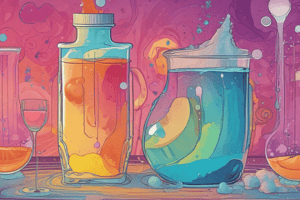Podcast
Questions and Answers
What is the primary method of water movement in the body?
What is the primary method of water movement in the body?
- Active transport
- Diffusion
- Osmosis (correct)
- Facilitated diffusion
Which of the following best describes the composition of intracellular fluids?
Which of the following best describes the composition of intracellular fluids?
- High in HCO3- and Na+
- High in Ca++ and protein
- High in K+ and phosphate (correct)
- High in Na+ and Cl-
What triggers the production of ADH in the body?
What triggers the production of ADH in the body?
- Decreased extracellular fluid
- Decreased sodium levels
- Increased blood osmotic pressure (correct)
- Increased blood volume
What is the primary regulator of water intake in the body?
What is the primary regulator of water intake in the body?
Which fluid compartment contains approximately 80% of extracellular water?
Which fluid compartment contains approximately 80% of extracellular water?
Which hormone is responsible for promoting sodium and water reabsorption?
Which hormone is responsible for promoting sodium and water reabsorption?
What physiological condition can stimulate the osmoreceptors in the hypothalamus?
What physiological condition can stimulate the osmoreceptors in the hypothalamus?
What is a common cause of dehydration apart from excessive sweating?
What is a common cause of dehydration apart from excessive sweating?
Flashcards are hidden until you start studying
Study Notes
Body Fluid Balance
- Balance: A state of equilibrium where substances are maintained in the right amounts and locations within the body.
Water Balance
- Osmosis: The primary method of water movement into and out of body fluid compartments.
- Osmosis: The movement of water molecules across a selectively permeable membrane from a region of high water concentration to a region of lower water concentration.
- Solute Concentration: The concentration of solutes determines the direction of water movement.
- Electrolytes: Most solutes in the body are electrolytes—inorganic compounds that dissociate into ions in solution.
- Sodium and Water: "Where sodium goes, water follows."
Body Water Distribution
- Total Body Water: Approximately 40 liters (10.56 gallons).
- Water Content by Age:
- Babies: 75% water
- Men: 63% water
- Women: 52% water
Body Fluid Compartments
- Fluid Compartments: Separated by selectively permeable membranes.
- Intracellular Fluid: 2/3 (63%) of total body water.
- Extracellular Fluid: 1/3 (37%) of total body water.
- Interstitial Fluid: 80% of extracellular water.
- Blood Plasma: 20% of extracellular water.
Composition of Body Fluid Compartments
- Extracellular Fluids: High in Na+, Cl-, Ca++, HCO3-.
- Blood Plasma: Contains more protein than interstitial fluid and lymph.
- Intracellular Fluids: High in K+, phosphate, Mg++, and more protein than plasma.
Regulation of Water Intake
- Thirst: The main regulator of water intake.
- Dehydration: A decrease in body water as little as 1% can cause:
- Decreased saliva production.
- Increased blood osmotic pressure, stimulating osmoreceptors in the hypothalamus.
- Decreased blood volume, leading to renin production.
Regulation of Water Output
- Urine Formation: Water output is regulated through urine formation.
- Antidiuretic Hormone (ADH): Production is stimulated by increased blood tonicity or decreased blood volume.
- ADH Action: Acts on distal convoluted tubules and collecting ducts of the kidney, increasing water reabsorption.
- Aldosterone: Production is stimulated by angiotensin II, which is produced via the renin-angiotensin system.
- Aldosterone Action: Causes sodium (and water) reabsorption.
- Atrial Natriuretic Peptide (ANP): Causes sodium (and water) loss when pressure in the right atrium is too high.
Water Imbalances
- Dehydration: The most common water imbalance.
- Causes of Dehydration:
- Prolonged diarrhea or vomiting.
- Excessive sweating.
Studying That Suits You
Use AI to generate personalized quizzes and flashcards to suit your learning preferences.




